Research on the Distribution and Scale Evolution of Suzhou Gardens under the Urbanization Process from the Tang to the Qing Dynasty
Abstract
:1. Introduction
2. Materials and Methods
3. The Evolution of the Suzhou Private Garden Distribution from the Tang to Qing Dynasty
4. The Scale Evolution of Suzhou Private Gardens in Different Dynasties
5. Discussion
5.1. How the Evolution of Suzhou City Affected the Distribution and Scale of Gardens?
5.2. Limitations and Insights for Future Research
6. Conclusions
Supplementary Materials
Author Contributions
Funding
Institutional Review Board Statement
Informed Consent Statement
Data Availability Statement
Acknowledgments
Conflicts of Interest
References
- Fan, C. Wu Jun Zhi; Zhengxing, X., Ed.; Jiangsu Classics Publishing House: Nanjing, China, 1999; p. 660. [Google Scholar]
- Zhao, Y. Wu Yue Chun Qiu; The Commercial Press: Shanghai, China, 1937; p. 41. [Google Scholar]
- Lu, G. Wu Di Ji; Zhonghua Book Company: Beijing, China, 1985; p. 8. [Google Scholar]
- Liu, D. Chinese Classical Gardens of Suzhou; Joseph, C.W., Ed.; McGraw-Hill: New York, NY, USA, 1993; pp. 11–20. [Google Scholar]
- Bai, Q. A preliminary study of relationship between ‘Chengshi (City)’ and ‘Shanlin (Landscape)’ in Chinese ancient literature. Chin. Landsc. Arch. 2019, 2, 125–128. [Google Scholar]
- Maggie, K.; Charles, J.; Alison, H. The Chinese Garden: History, Art and Architecture; Harvard University Press: Boston, MA, USA, 2003; p. 7. [Google Scholar]
- Wu, J. Jiangnan Gardens and Urban Society: A Social-Historical Analysis of Suzhou Gardens during the Ming and Qing Dynasties. Available online: http://www.mh.sinica.edu.tw/MHDocument/PublicationDetail/PublicationDetail_99.pdf (accessed on 31 January 2021).
- Xu, Y. Boundaries, centres and peripheries in Chinese gardens: A case of Suzhou in the eleventh century. Stud. Hist. Gard. Des. Lands 2012, 24, 21–37. [Google Scholar] [CrossRef]
- Mei, J. ‘Su Cheng Hao, Cheng Li Ban Yuan Ting’ Qianlong Gusu Cheng Tu Zhong Yuanlin Yongdi Guimo Ji Fenbu Yanjiu. J. Chin. Arch. Hist. 2010, 3, 217–504. [Google Scholar]
- Chen, Y. Xingtai, Leixing Yu Yiyi: Suzhou Gucheng Xingtai Yanhua Yanjiu; Southeast University Press: Nanjing, China, 2006; pp. 31–33. [Google Scholar]
- Chen, C. Bianqian Zhong De Yuanlin--Mingdai Yihou Suzhou Yuanlin Jianzhu Mianji De Bianhua Yu Diqu Renkou Biandong De Gualian. Xin Shiji Luncong 2006, 2, 9–11. [Google Scholar]
- Gu, G.; Yu, C.; Li, L.; Hong, D. The research of changes of the chinese cistorical private classical carden and the authenticity of the protection—A case study of the Yiyuan. J. Hum. Settl. West. China 2018, 5, 69–77. [Google Scholar]
- Ye, T.; Fang, H. Research on the historic appearance of the Lion Grove from the Yuan dynasty to the Republic of China. Stud. Hist. Gard. Des. Lands 2017, 37, 1–14. [Google Scholar] [CrossRef]
- Zhang, T.; Wang, H.; Lian, Z. Research on the preservation and continuation of private gardens in Suzhou in perspective of the history changes of Canglang Pavilion. Chin. Landsc. Arch. 2018, 2, 133–137. [Google Scholar]
- Qu, W. Suzhou Hedao Zhi; Jilin People’s Publishing House: Changchun, China, 2007. [Google Scholar]
- Olivia, M. Urbanization in Early and Medieval China: Gazetteers for the City of Suzhou; University of Washington Press: Seattle, WA, USA, 2015; p. 89. [Google Scholar]
- Zhang, Y. The Atlas of Ancient Suzhou; Gu Wu Xuan Publishing House: Suzhou, China, 2004. [Google Scholar]
- Fu, W. Tang Hui Yao; Zhonghua Book Company: Beijing, China, 1955; p. 1239. [Google Scholar]
- Lu, G. Bai Ou Shi Xu. In Suzhou Yuanlin Lidai Wenchao; Yi, X., Ed.; SDX Joint Publishing Company: Shanghai, China, 2008; p. 1. [Google Scholar]
- Wang, J. Song Pingjiang Chengfang Kao; Jiangsu Classics Publishing House: Nanjing, China, 1999; p. 35. [Google Scholar]
- Yuan, L. Songdai Chengshi Xingtai He Guanshu Jianzhu Zhidu Yanjiu; China Architecture & Building Press: Beijing, China, 2013; p. 78. [Google Scholar]
- Wei, J. Suzhou Gudian Yuanlin Shi; SDX Joint Publishing Company: Shanghai, China, 2006; p. 181. [Google Scholar]
- Gong, M. Zhong Wu Ji Wen; Zhonghua Book Company: Beijing, China, 1985; pp. 87–89. [Google Scholar]
- Xu, D. Jin Yu Lu. Available online: https://fzk.szlib.com/book/detail?bookId=219 (accessed on 31 January 2021).
- Su, S. Cang Lang Ting Ji. In Suzhou Yuanlin Lidai Wenchao; Yi, X., Ed.; SDX Joint Publishing Company: Shanghai, China, 2008; p. 4. [Google Scholar]
- Conzen, M.R.G. Alnwick, Northumberland: A Study of Town—Plan Analysis; Institute of British Geographers Publication: London, UK, 1960; p. 27. [Google Scholar]
- Wang, A. Gusu Zhi; Bibliography and Document Publishing House: Beijing, China, 1990; p. 262. [Google Scholar]
- Fan, J.; Xia, W. Suzhou Diqu Shehui Jingji Shi Mingqing Juan; Lun, L., Ed.; Nanjing University Press: Nanjing, China, 1993; pp. 61–82. [Google Scholar]
- Dai, M. Lyu Yin Zhai Gu Gui Ji. In Suzhou Yuanlin Lidai Wenchao; Yi, X., Ed.; SDX Joint Publishing Company: Shanghai, China, 2008; p. 111. [Google Scholar]
- Li, D. Dong Zhuang Ji. In Suzhou Yuanlin Lidai Wenchao; Yi, X., Ed.; SDX Joint Publishing Company: Shanghai, China, 2008; pp. 9–60. [Google Scholar]
- Xu, Y. Ruyi Tang Ji. In Suzhou Yuanlin Lidai Wenchao; Yi, X., Ed.; SDX Joint Publishing Company: Shanghai, China, 2008; pp. 19–20. [Google Scholar]
- Han, Y. Feng Xi Cao Tang Ji. In Suzhou Yuanlin Lidai Wenchao; Yi, X., Ed.; SDX Joint Publishing Company: Shanghai, China, 2008; p. 58. [Google Scholar]
- Wang, S. Wan Pu Ji. In Suzhou Yuanlin Lidai Wenchao; Yi, X., Ed.; SDX Joint Publishing Company: Shanghai, China, 2008; p. 60. [Google Scholar]
- Li, G.; Gu, Y. (Qianlong) Changzhou Xian Zhi; Jiangsu Classics Publishing House: Nanjing, China, 1991; p. 184. [Google Scholar]
- Tang, C. Huang Huang Zhai Ji bing Ming. In Suzhou Yuanlin Lidai Wenchao; Yi, X., Ed.; SDX Joint Publishing Company: Shanghai, China, 2008; p. 73. [Google Scholar]
- Jiang, Y. Hou Le Tang Ji. In Suzhou Yuanlin Lidai Wenchao; Yi, X., Ed.; SDX Joint Publishing Company: Shanghai, China, 2008; p. 50. [Google Scholar]
- Gui, Z. Ba Jiang Gei Jian Bian E Hou. In Suzhou Yuanlin Lidai Wenchao; Yi, X., Ed.; SDX Joint Publishing Company: Shanghai, China, 2008; p. 69. [Google Scholar]
- Xu, Y. The Scroll of the Flourishing Times; Liaoning Provincial Museum, Ed.; Cultural Relics Publishing House: Beijing, China, 1986. [Google Scholar]
- Niu, R.; Wang, H. (Chongzhen) Wu Xian Zhi. Available online: https://fzk.szlib.com/book/detail?bookId=22 (accessed on 31 January 2021).
- Qian, Y. Lyu Yuan Cong Hua; Shanghai Classics Publishing House: Shanghai, China, 2012; p. 8. [Google Scholar]
- Henderson, R. The Gardens of Suzhou: Penn Studies in Landscape Architecture; University of Pennsylvania Press: Philadelphia, PA, USA, 2013. [Google Scholar]
- Ruggia, J. Heaven Above, Suzhou Below. Travel Agent 2002, 310. [Google Scholar]
- Dunzhen, L. History of Ancient Chinese Architecture; China Architecture & Building Press: Beijing, China, 1980; p. 164. [Google Scholar]
- Yi, W. Zhongguo Yuanlin Wenhua Shi; Shanghai People Publisher: Shanghai, China, 2004; pp. 445–457. [Google Scholar]
- Qishou, D. Suzhou Yuanlin Shanshuihua Xuan; SDX Joint Publishing Company: Shanghai, China, 2007; pp. 16–28. [Google Scholar]
- Wang, S. Qiu Zhi Yuan Ji. In Suzhou Yuanlin Lidai Wenchao; Yi, X., Ed.; SDX Joint Publishing Company: Shanghai, China, 2008; p. 66. [Google Scholar]
- Feng, G. (Tongzhi) Suzhou Fu Zhi; Cheng Wen Publishing House: Taipei, Taiwan, 1983; p. 1284. [Google Scholar]
- Wen, Z. Wen Zhengming Ji; Shanghai Classics Publishing House: Shanghai, China, 1987; Volume 12, p. 333. [Google Scholar]
- Yi, X.; Chen, W. (Eds.) Ou Yuan Zhi; Wen Hui Press: Shanghai, China, 2013; pp. 1–2. [Google Scholar]
- Keswick, M.; Charles, J.; Alison, H. The Chinese Garden: History, Art and Architecture; Maggie, K., Ed.; Harvard University Press: Cambridge, MA, USA, 2003; pp. 6–12. [Google Scholar]
- Wan, W. Shao Hua Shu Wu Ji. In Suzhou Yuanlin Lidai Wenchao; Yi, X., Ed.; SDX Joint Publishing Company: Shanghai, China, 2008; p. 110. [Google Scholar]
- Wang, J. Tui Yuan Bu Ji. In Suzhou Yuanlin Lidai Wenchao; Yi, X., Ed.; SDX Joint Publishing Company: Shanghai, China, 2008; p. 108. [Google Scholar]
- Zhu, S. Yi Ju Tu Ji. In Suzhou Yuanlin Lidai Wenchao; Yi, X., Ed.; SDX Joint Publishing Company: Shanghai, China, 2008; p. 106. [Google Scholar]
- Jiang, G. Xiu Gu Ji. In Suzhou Yuanlin Lidai Wenchao; Yi, X., Ed.; SDX Joint Publishing Company: Shanghai, China, 2008; p. 104. [Google Scholar]
- Wu, Y. Dong Zhai Ji. In Suzhou Yuanlin Lidai Wenchao; Yi, X., Ed.; SDX Joint Publishing Company: Shanghai, China, 2008; p. 103. [Google Scholar]
- Yuan, X. Shuang Ta Ying Yuan Ji. In Suzhou Yuanlin Lidai Wenchao; Yi, X., Ed.; SDX Joint Publishing Company: Shanghai, China, 2008; p. 83. [Google Scholar]
- You, D. Shui Zhai Xuan Ji. In Suzhou Yuanlin Lidai Wenchao; Yi, X., Ed.; SDX Joint Publishing Company: Shanghai, China, 2008; p. 80. [Google Scholar]
- Qian, Z. Suzhou Gucheng Bianqian Lue Lun. In Suzhou Lishi Xuehui Wenxuan; Suzhou Historical Institute: Suzhou, China, 1983; pp. 98–106. [Google Scholar]
- Lu, X. (Hongwu) Suzhou Fu Zhi; Cheng Wen Publishing House: Taipei, Taiwan, 1983; p. 421. [Google Scholar]
- Shuji, C. Hongwu Shiqi Dongnanfu, Xianzhi Chengshi Renkou Shuliang Yanjiu--Yi Jingshi, Fujian He Jiangxi Weili. Res. Chin. Econ. Hist. 1999, 1, 19–33. [Google Scholar]
- Ya Er, H.S. (Qianlong) Suzhou Fu Zhi. Available online: https://fzk.szlib.com/book/detail?bookId=35 (accessed on 31 January 2021).
- Song, R.; Shi, W. (Daoguang) Suzhou Fu Zhi. Available online: https://fzk.szlib.com/book/detail?bookId=23 (accessed on 31 January 2021).
- Wang, W. Wu Wenhua Yu Jiangnan Shehui Yanjiu; Qunyan Press: Beijing, China, 2005; p. 285. [Google Scholar]
- Zhang, G. Wuzhong Shuili Quanshu. Available online: http://reader.szlib.com/opac/book/610780 (accessed on 31 January 2021).
- Craig, C. Fruitful Sites: Garden Culture in Ming Dynasty China; Duke University Press: Durham, NC, USA, 1996; p. 16. [Google Scholar]
- Chen, J. Yi Yuan. In Yi Yuan Zhi; Yi, X., Chen, W., Eds.; Wen Hui Press: Shanghai, China, 2013. [Google Scholar]
- San Ren, Y.L.; Shi, Z. Yuan Yi; Architecture & Building Press: Beijing, China, 2013; pp. 3–38. [Google Scholar]
- Bureau of Suzhou Real Estate Management. Ancient Residences in Suzhou; Tongji University Press: Shanghai, China, 2004; p. 187.
- Yu, Y. Qingdai Guanzhi Yu Fushi; Liaoning Nationality Publishing House: Shenyang, China, 2009; p. 68. [Google Scholar]
- Chen, C. Traditional Suzhou Dwellings; SDX Joint Publishing Company: Shanghai, China, 2003; p. 153. [Google Scholar]
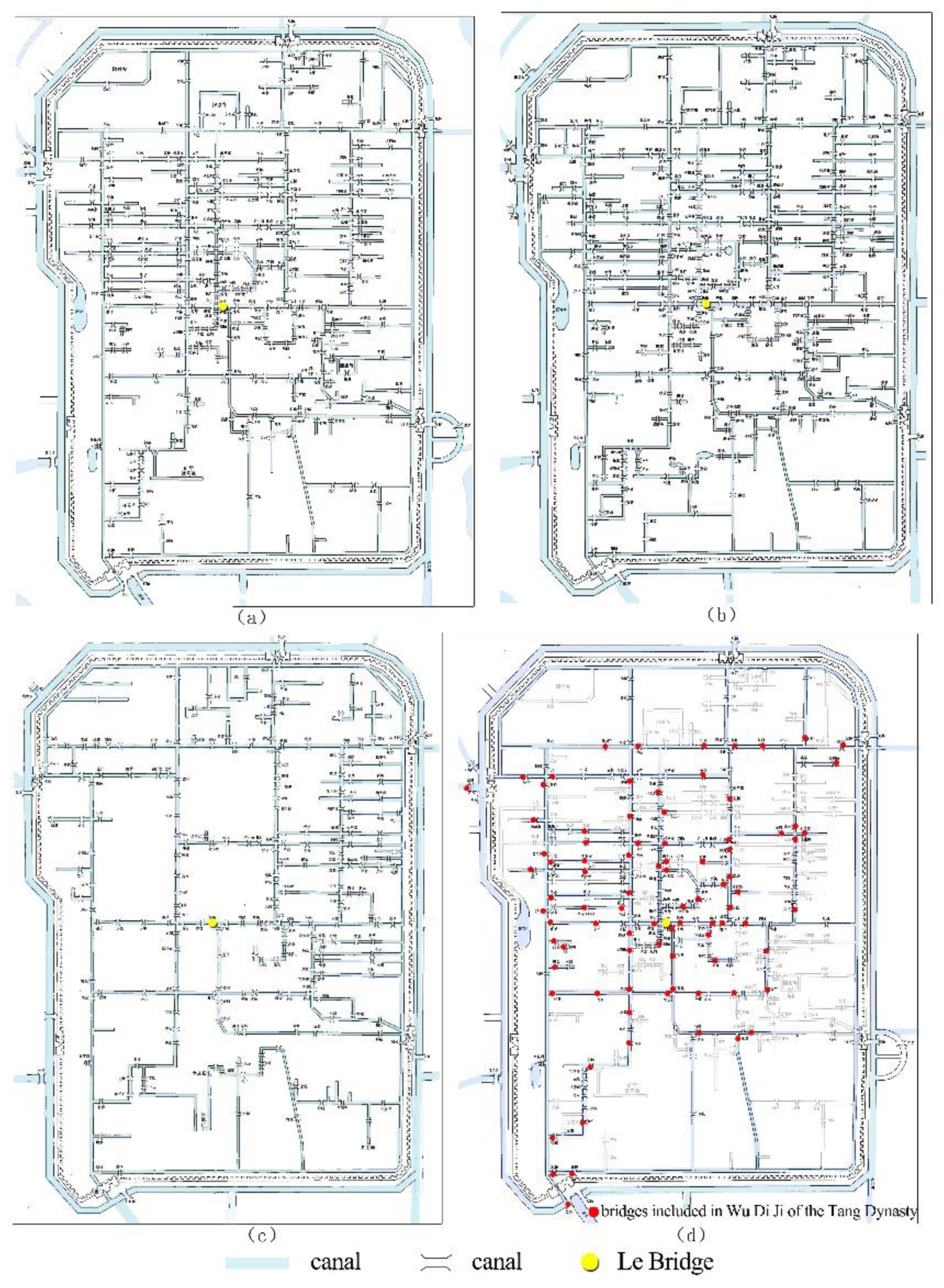
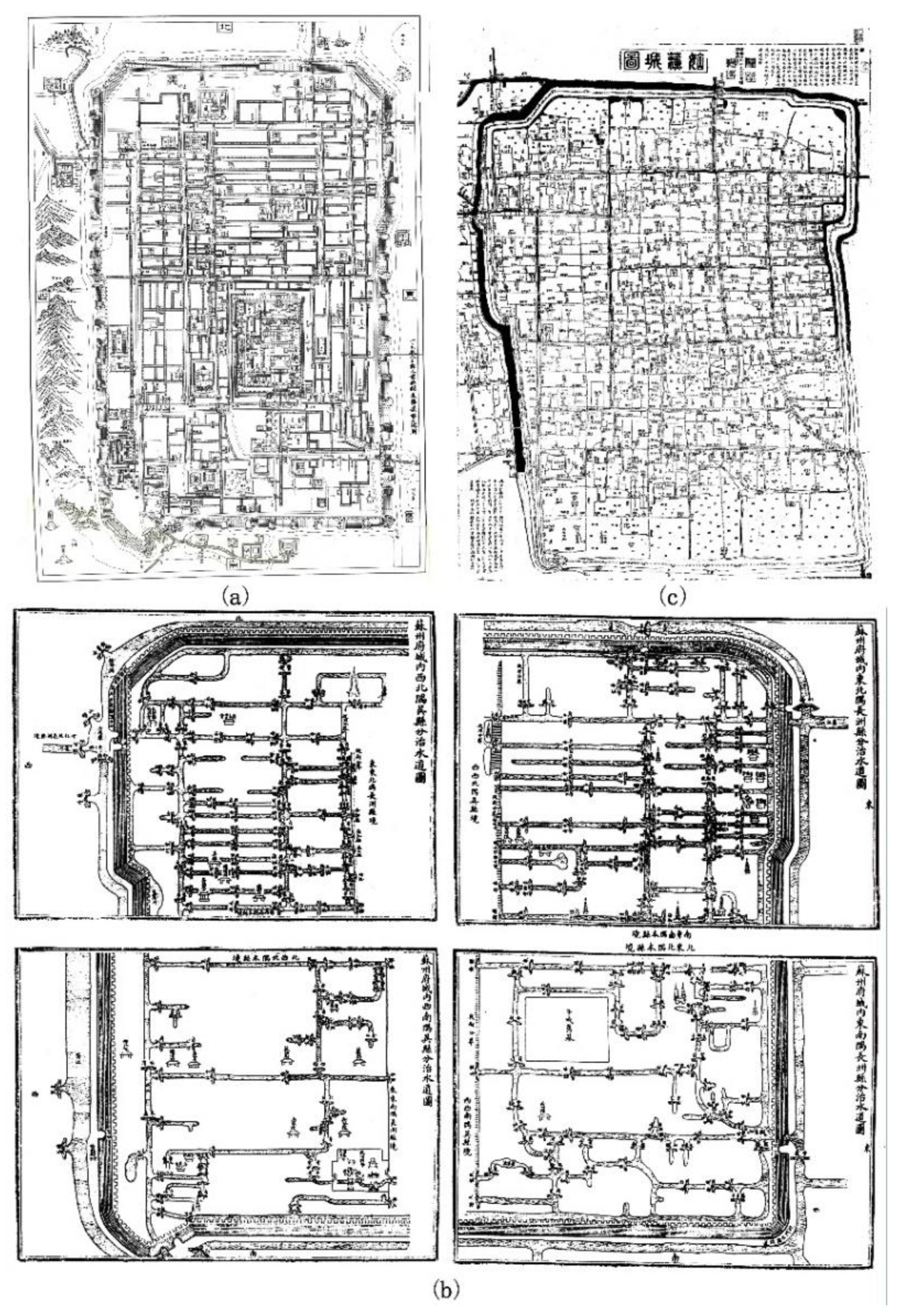
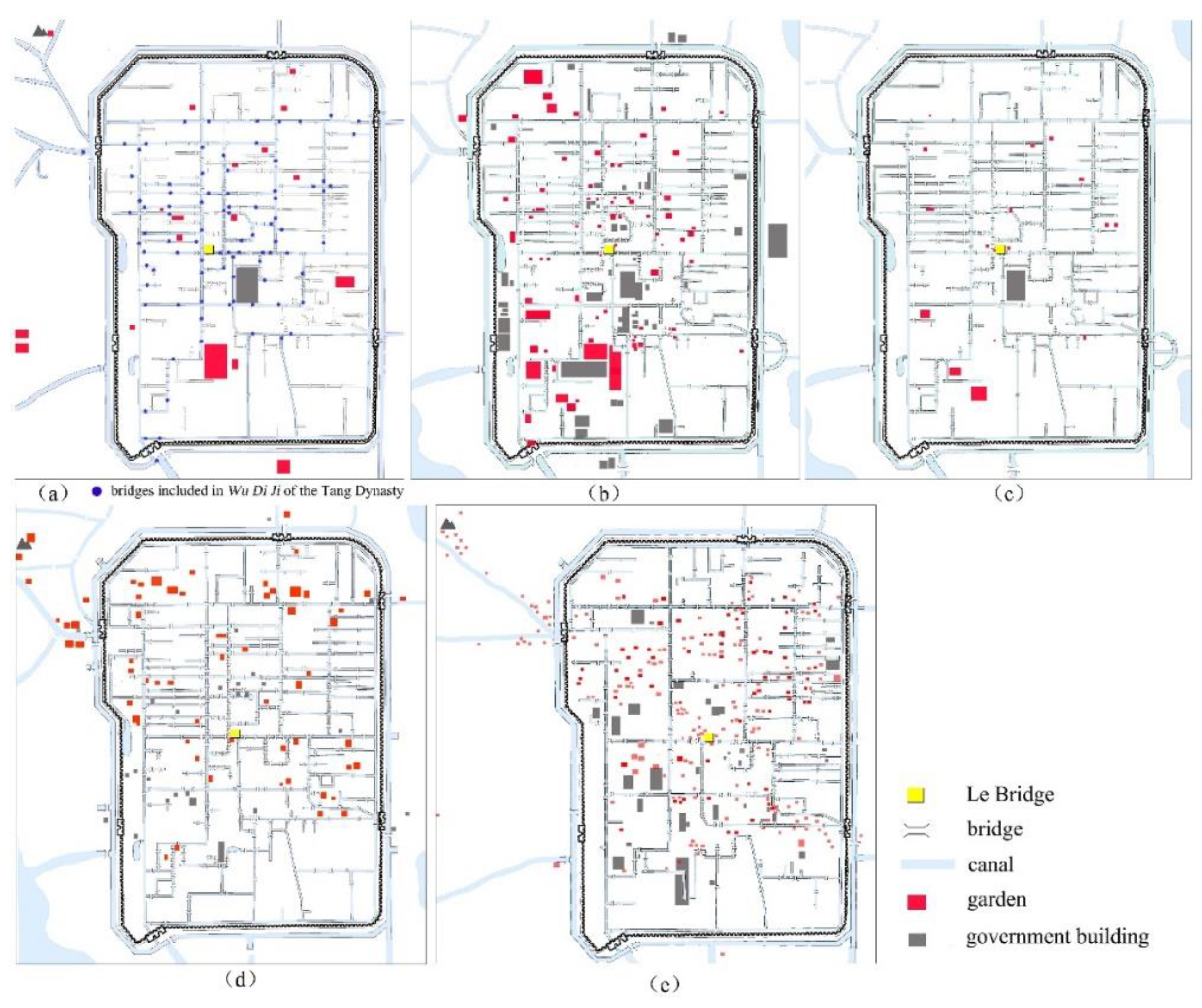
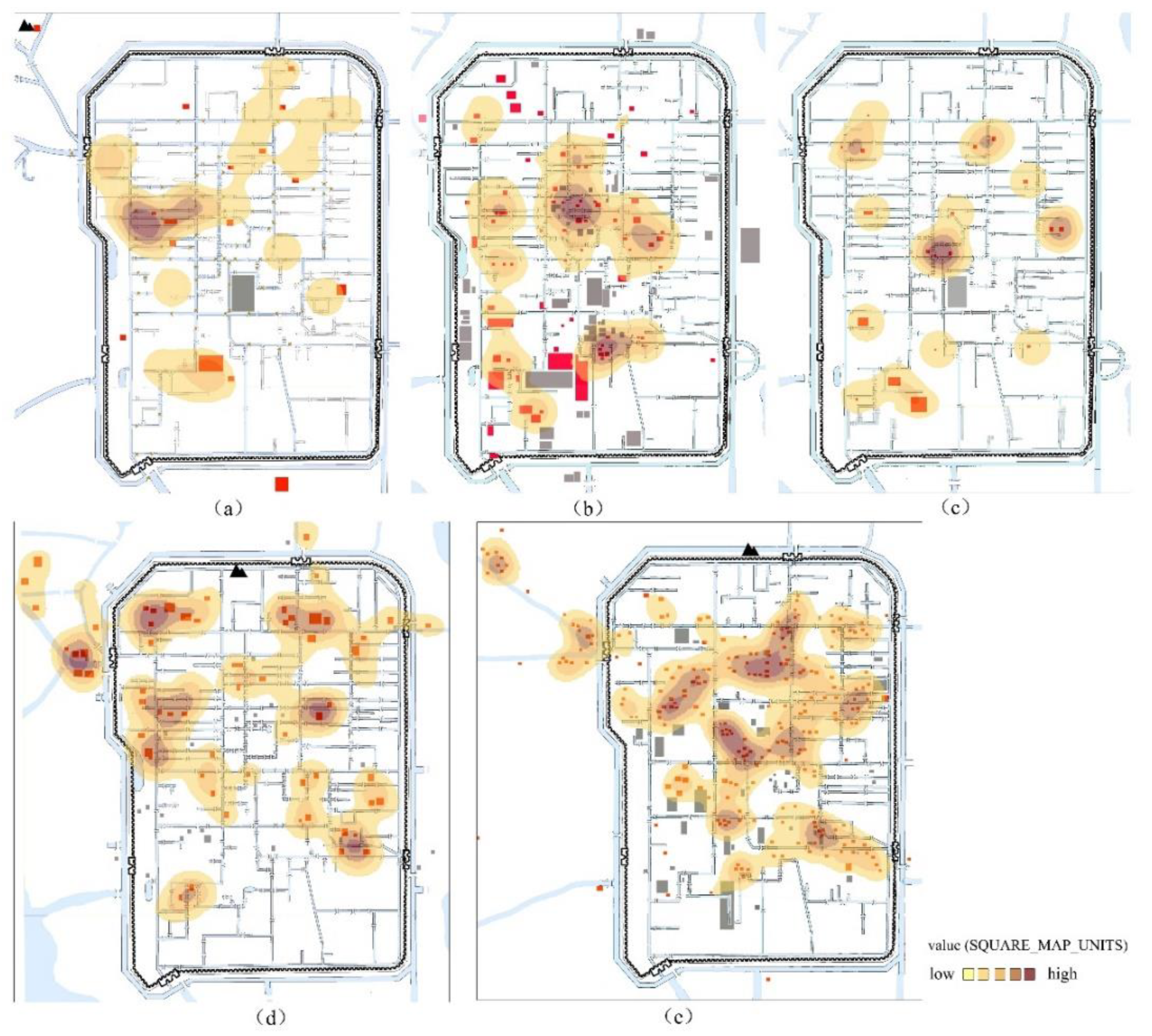
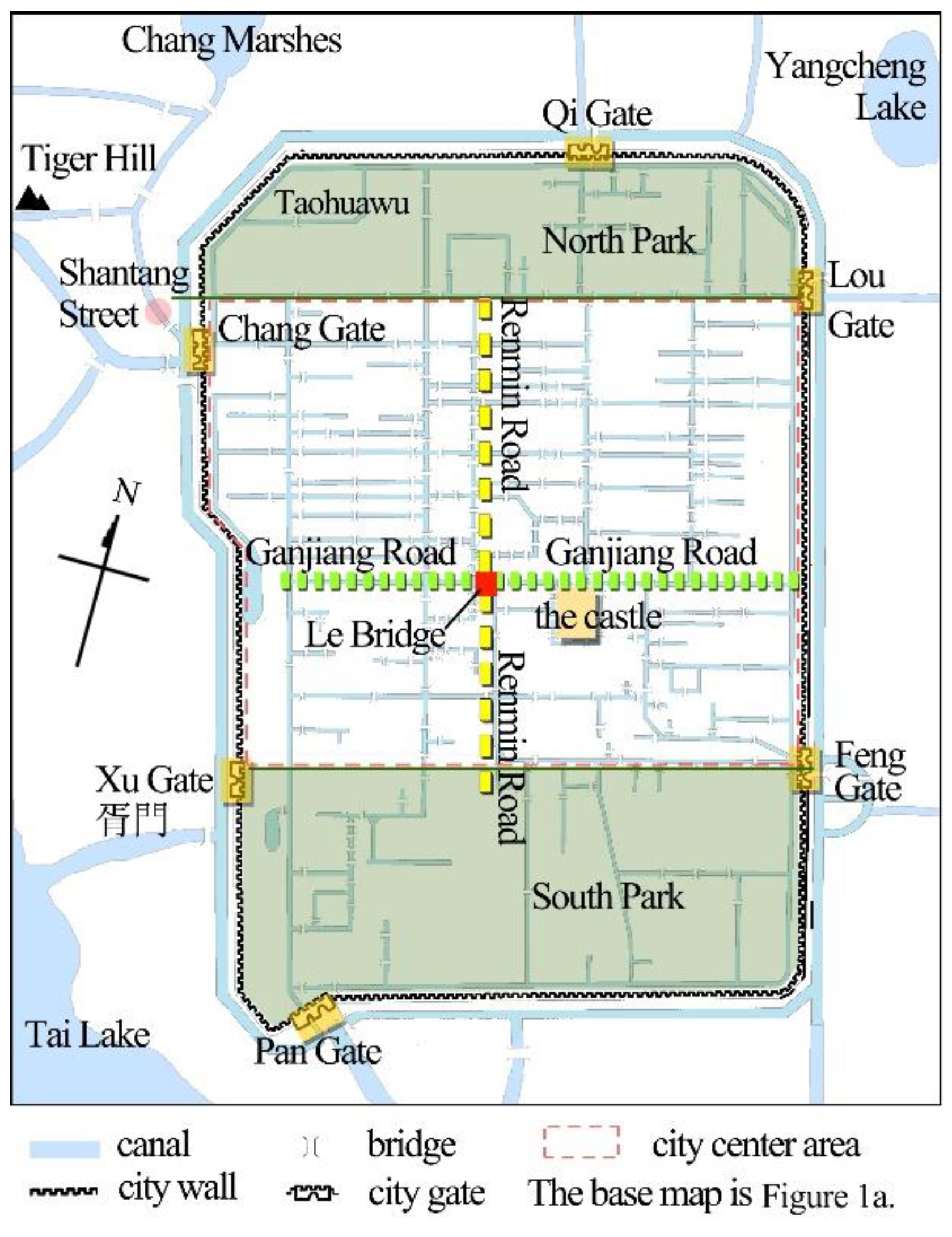
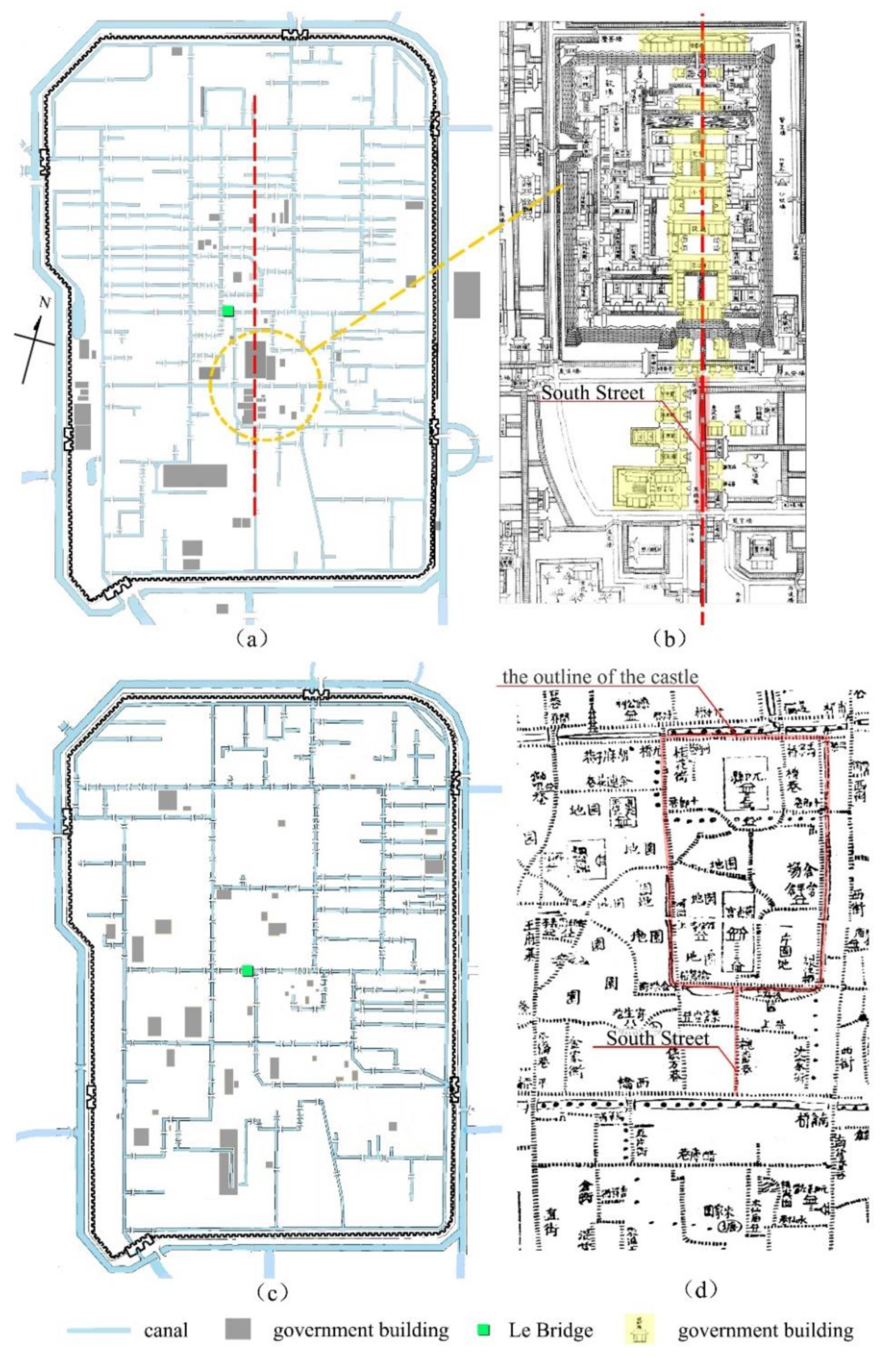

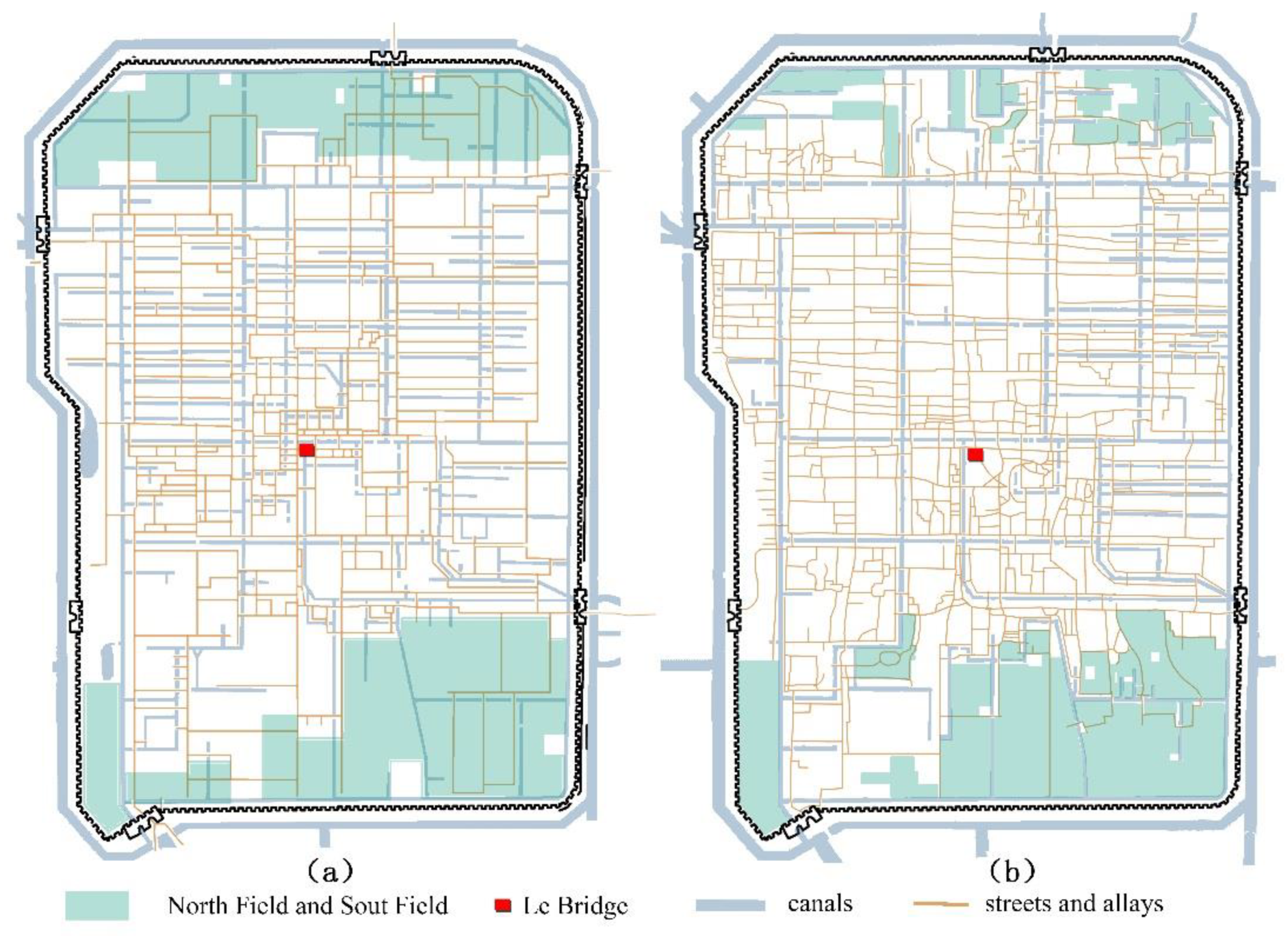
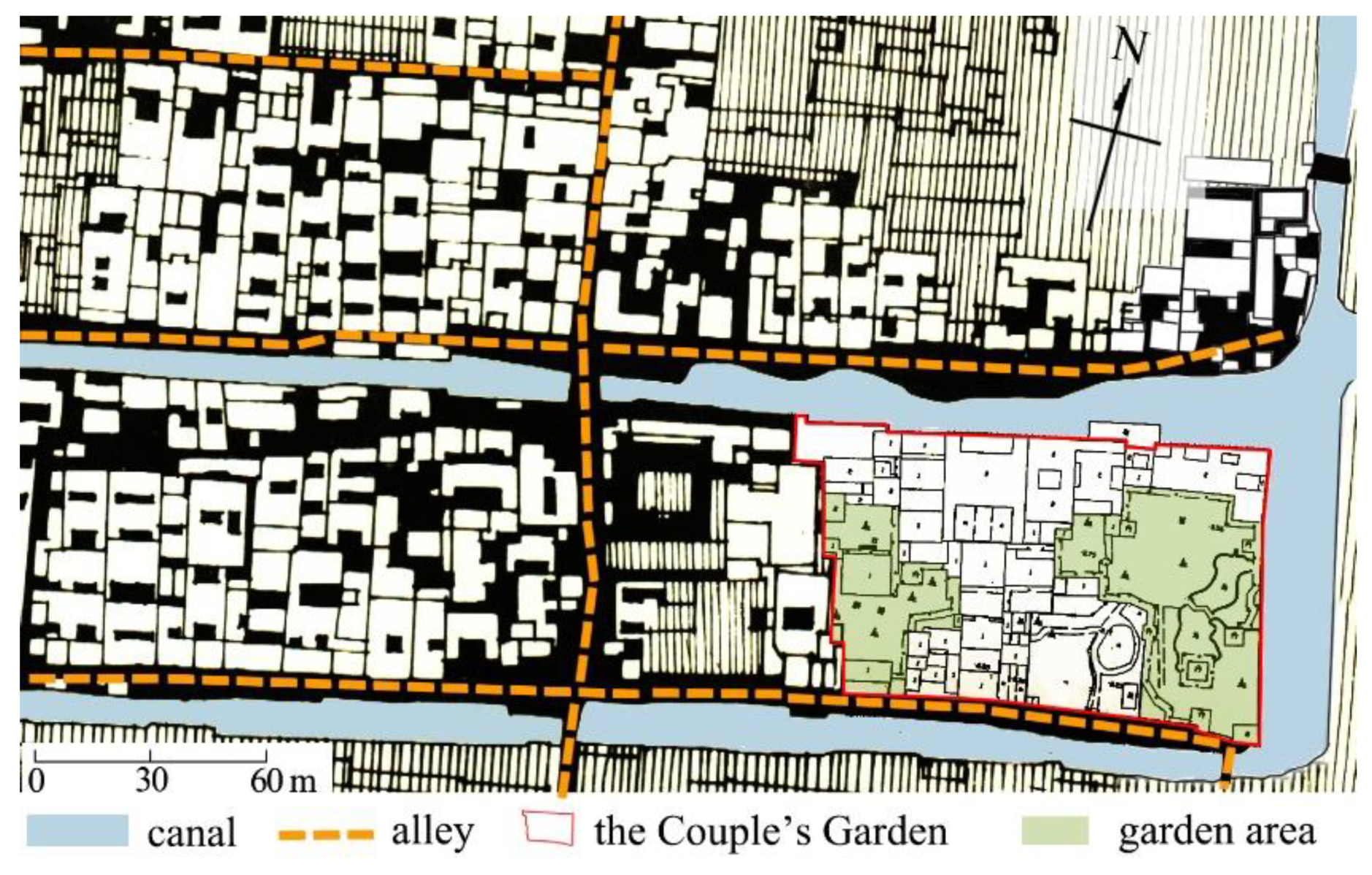
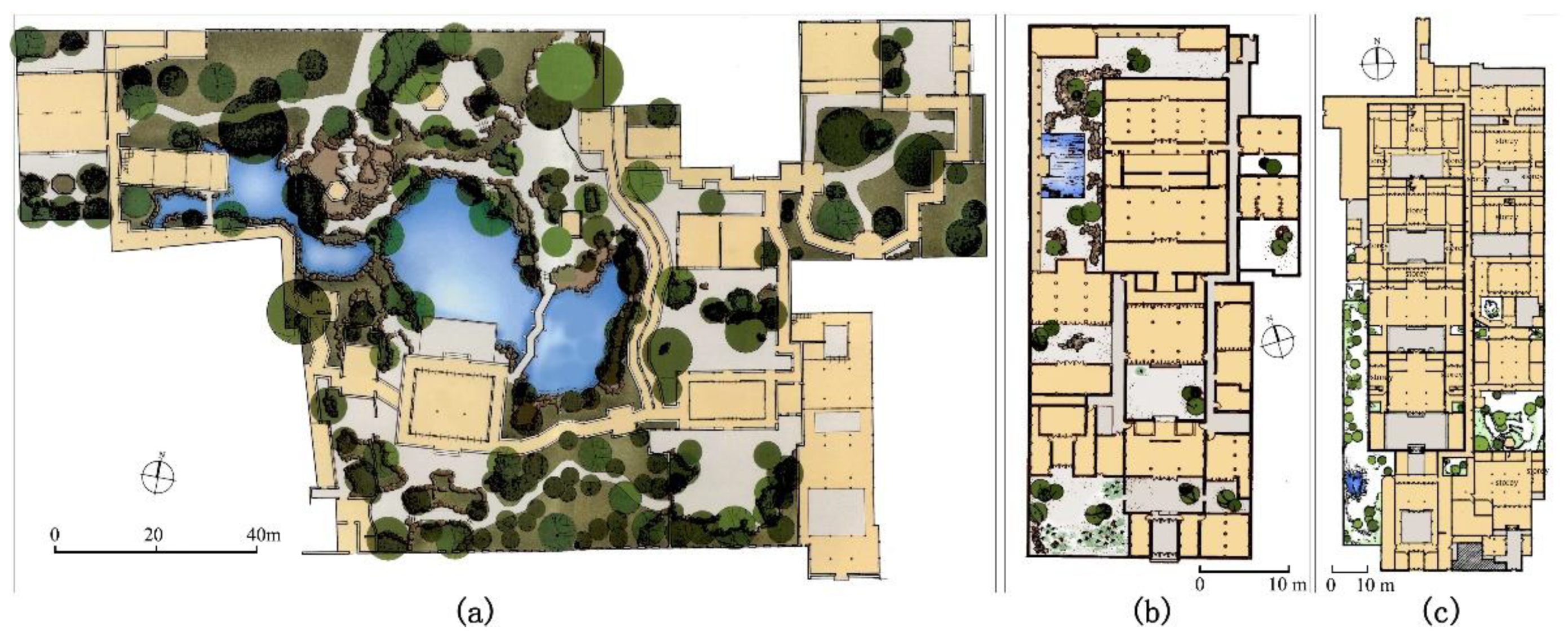

| Name | Owner (Profession) | Description of the Scale |
|---|---|---|
| Renhui’s Garden | Ren Hui (a district defender) | a few mu [19] |
| South Garden | Qian Yuanliao (the prince of Ng-Yuih Kingdom) | around 35 ha. [20] |
| East Garden | Qian Wenfen (the son of Qian Yuanliao) | around 60 mu [1] (p. 191) |
| Sun Chengyu’s Garden | Sun Chengyou (the brother-in-law of Qian Yuanliao) | the water pool covered dozens of mu [1] (p. 187) |
| Garden Name | Owner (Professions) | Description of the Scale |
|---|---|---|
| Le Pu | Zhu Changwe (a government director) | more than 30 mu [1] (pp. 193–195) |
| Tongle Garde | Zhu Mian (a minion) | extremely vast [23] |
| Taohuawu Villa | Zhang Jie (a grand preoeptor) | 700 mu [24] |
| Canglang Pavillion | Su Shunqin (a civil official) | around 30 mu [25] |
| Snail Cottage | Cheng Ju (an assistant magistrate) | This house can only accommodate two knees. Although it has a door, the carriage can’t get in. [1] (pp. 199–200) |
| Han’s Garden | Han Shizhong (a general) | # around 200 mu |
| Zhang’s Garden | Zhang Ziyan (a vice director) | # around 150 mu |
| Yang’s Garden | Yang Cunzhong (a general) | # more than 100 mu |
| Garden Name | Owner (Status) | Description of the Scale |
| Zhu’s Garden | Family Zhu (unknown) | 200 mu [29] |
| East Manor | Wu Kuan (a minister) | 60 mu [30] |
| Du Qiong’s Garden | Du Qiong (an artist & bibliophile) | less than 1 mu [31] |
| Feng Creek Cottage | Han Yong (an assistant minister) | 30 mu [32] |
| Wan Pu | Qian Menghu (an artist) | several mu [33] |
| Humble Administrator’s Garden | Wang Xiancheng(a censor) | more than 200 mu [34] |
| Zi Zhi Garden | Xu Mochuan (a collector) | a dozen of mu [1] (pp. 196–197) |
| Huang Huang Zhai | Tang Chuanyin (a writer) | too small to accommodate two knees [35] |
| East Garden | Xu Taishi (a government sub-director) | a water pool with an area of 2 mu [36] |
| Zui Ying Tang | Yuan Zugeng (a judicial commissioner) | several mu [37] |
| Garden Name | Owner (Professions) | Description of the Scale and Its Source |
|---|---|---|
| Couple’s Garden | Lu Jin (a prefect) | # around 7740 m2 |
| Yi Garden | Gu Wenbin (an intendant) | # around 4440 m2 |
| Ting Feng Garden | Wu Yun (a prefect) | # around 1310 m2 |
| Qu Garden | Yu Yue (a litterateur) | # total 3020 m2, garden area around 450 m2 |
| Shao Hua Study | Wang Wan (a litterateur) | sveral gong wide [51] |
| Tui Garden | Wu Jiaquan (a litterateur) | sveral gong wide [52] |
| Zhu’s House | Zhu Shou (an aide and staff) | the courtyard was 4 or 5 Chi wide [53] |
| Xiu Gu | Jiang Gai (a first-degree scholar) | the garden was less than ten hu wide [54] |
| Dong Zhai | Wu Yifeng (a bibliophile) | the garden was less than ten hu wide [55] |
| Shuang Ta Ying Garden | Yuan Xuelan (a bibliophile) | a little over 1 mu [56] |
| Yi Garden | You Tong (a dramatist) | around 10 mu [57] |
| Bei Ban Garden | Lu Xiemei (a circuit intendant) | # around 1160 m2 |
| Chang Garden | Wang (a circuit intendant) | # total 2820 m2, garden area around 1 mu |
| Can Li Garden | unknown name (a salt merchant) | # total 2390 m2, garden area around 140 m2 |
Publisher’s Note: MDPI stays neutral with regard to jurisdictional claims in published maps and institutional affiliations. |
© 2021 by the authors. Licensee MDPI, Basel, Switzerland. This article is an open access article distributed under the terms and conditions of the Creative Commons Attribution (CC BY) license (http://creativecommons.org/licenses/by/4.0/).
Share and Cite
Zhang, T.; Lian, Z. Research on the Distribution and Scale Evolution of Suzhou Gardens under the Urbanization Process from the Tang to the Qing Dynasty. Land 2021, 10, 281. https://doi.org/10.3390/land10030281
Zhang T, Lian Z. Research on the Distribution and Scale Evolution of Suzhou Gardens under the Urbanization Process from the Tang to the Qing Dynasty. Land. 2021; 10(3):281. https://doi.org/10.3390/land10030281
Chicago/Turabian StyleZhang, Tiantian, and Zefeng Lian. 2021. "Research on the Distribution and Scale Evolution of Suzhou Gardens under the Urbanization Process from the Tang to the Qing Dynasty" Land 10, no. 3: 281. https://doi.org/10.3390/land10030281






